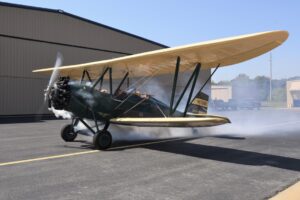Project Description

MPH
SEATS
New Standard D25
Role: Single Pilot Four Passenger Aircraft
National Origin: United States
Manufacturer: New Standard
First Flight: 1930
Number Built: unknown
The familiar “Standard” biplane of the first World War period was a large but rather graceful airplane, a pleasant airplane that was quite docile and obedient. The “New Standard” biplane of some 10 years later, was almost like a re-incarnation of this old favorite, just done up in more modern dress. The “Hisso” (Hispano – Suiza) powered model D24 was the first of this series and a very unusual airplane for this particular time, reminding one very much of the old Pitcairn, Sikorsky, Woodson, and other such biplanes that were built back in the 1923-1925 era.
Airplanes that carried four passengers and a pilot, all out in the open, may have looked outmoded by now, but it was actually a very sensible arrangement, one that worked out quite well for carrying passengers on short joy-rides around the vicinity of the air-field. The occupants certainly enjoyed the thrill and the feel of the open cockpit, and 4 paying passengers enabled the operator to show a fairly decent profit on a busy weekend. The D25 was actually designed in anticipation of the revival of the “barnstorming era” of a few years back; joy-riding was still quite popular with the average airport visitor who brought the wife and kids to look around.
The New Standard model D25A, was typical to the previous model D25 in all respects, except for the powerplant installation which was now the 7 cyl. Wright J6 engine of 225 h.p. The D25A was also a 5 place open cockpit biplane seating four passengers in one large open cockpit up forward, and the pilot was seated in an open cockpit further back. Largely concerned with a substantial paying load and good short-field performance, the “New Standard” in this series were particularly endowed with a generous amount of efficient wing area; the huge upper wing had a graceful sweep and the small lower wing approached the sesquiwing arrangement. Though large and quite bulky, the “New Standard” was a graceful and amiable airplane that offered a surprisingly good performance in spite of its over-sized proportions.
NC7286 has been a ride hopping biplane for many years. It was acquired by the museum in flyable condition but was sent to restoration in Ohio and restored to its present condition in 2022.
General characteristics
- Crew: 1
- Capacity: 4 pax
- Length: 26 ft 10 in
- Wingspan: 45 ft
- Height: 10 ft 2 in
- Wing area: 240/100 sq ft
- Powerplant: 1 × Wright air-cooled radial piston engine, 225 hp
- Propellers: 2-bladed fixed-pitch propeller
- Empty weight: 2,055 lb
- Gross weight: 3,345 lb
Performance
- Maximum speed: 110 mph
- Cruise speed: 90 mph
- Range: 440 mi
- Service ceiling: 18,000 ft